Wellington: Primitive Methodism in Wellington, NZ


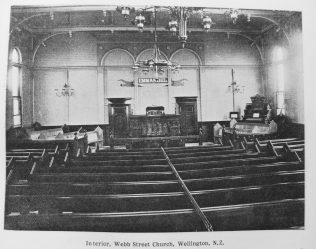
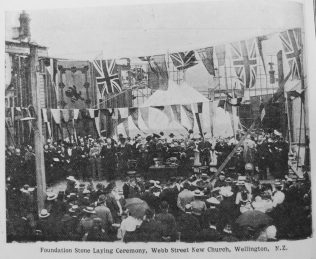

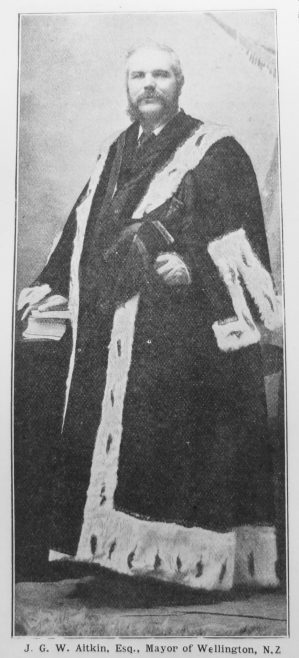
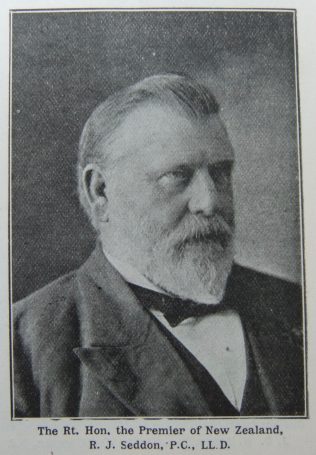

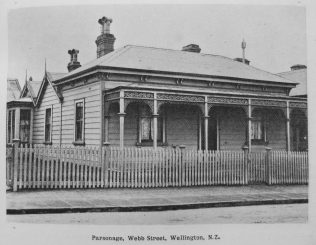
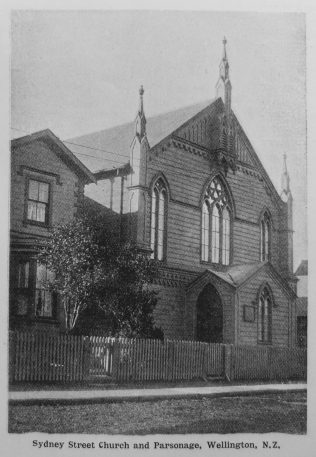
Transcription of Article in the Primitive Methodist Magazine by J. Crocker
WELLlNGTON, the “Empire City” of New Zealand, is situated at the Southern extremity of the North Island. The harbour opens out into Cook’s Strait, the waters of which separate the North and South Islands of New Zealand. European settlement in Wellington commenced in the year 1840, when the “Aurora,” the first emigrant ship arrived with 146 passengers on board. At that time the sea washed up to the foot of the hills, and the forest overhung the waters of the harbour. Where Wellington stands to-day, some 60 years ago; the forest grew, and civilization was practically unknown. The emigrants entered upon the work of settlement with enthusiasm, the trees were cut down, houses built with the timber, and soon a small township appeared which was named Britannia, but was afterwards changed to Wellington as a compliment to the Duke of Wellington. Many were the hardships of those early settlers, and the difficulties they had to overcome, but they bravely persevered, and the present generation is reaping the benefit of their labours. It is not within the scope of this article to follow the highly interesting story of the settlement and progress of the city. Suffice it to say that to-day it has a population of about 50,000, and is rapidly growing. It is the seat of government, and being the central city of the colony, many colonial firms are removing their headquarters to Wellington, and this centralising policy will doubtless increase the growth and importance of the city.
Primitive Methodism was introduced into Wellington in the year 1847 by the Rev. Robert Ward, the sainted founder and pioneer missionary of Primitive Methodism in New Zealand. The following extracts from his journal referring to his first visit to the city are very interesting.
“January 23rd. On January 16th (Saturday) about noon, I bade farewell to my dear family and friends (at New Plymouth) and went on board the Government brig ‘Victoria,’ bound for Wellington. After tossing about we got into Port Nicholson just before sundown on Friday evening, January 22nd. Praise God for all his mercies! After trying in vain to procure private lodgings, I had some tea, a bed, and breakfast at a public house. The next morning I called on Rev. J. Watkins, Wesleyan minister, and was very kindly received. After I had been at Mr. Watkins’ a few minutes, Mr. Ironsides came to see me and breathed the same Christian spirit. They kindly interested themselves in assisting me to procure lodgings. My thoughts and feelings on my entrance into this settlement no one can tell but God.
“January 24th (Sunday). I commenced my labours in this settlement today by visiting many families and preaching three times in the open-air in different parts of the town. The congregations consisted of several soldiers, sailors, policemen, professors of religion, and several who it is likely scarcely ever listened to a sermon before.”
The heroic missionary then speaks of scrambling through the bush, preaching in the open-air, then conducting cottage meetings, visiting the homes of the people, gathering good congregations, then being cast down at the poor prospects of saving sinners, and when most cast down a man came to inform him of a wicked man who had got converted under the missionary’s preaching the previous Sabbath. Mr. Ward laboured on until the following March, when he returned to New Plymouth, which he reached in seven days, after being tossed about in a gale for several days. In May, 1847, the Rev. H. Green took charge of the mission work in the district, and at the September Quarterly Meeting 34 members of society were reported. The site of the present Sydney Street church was secured, and a mud church was erected, which was destroyed by an earthquake in October, 1848. Within three weeks after its destruction the mud church was replaced by a plain weather-board building. For ten years Mr. Green remained in charge of the Mission, and, during his pastorate, churches were erected in Wellington, Tawa Flat, the Hull and Stokes Valley.
We can only make passing reference in this short sketch of the various ministers who have laboured in the Wellington circuits. In 1857 the Rev. Joshua Smith took charge of the Mission and remained in charge for seven years, during which time the Sydney Street Church was rebuilt. In 1861 the Rev. J.D. Whittaker was appointed as Mr. Smith’s colleague, but after ten month’s labours he sickened and died. In 1864 Mr. Smith was succeeded by the Rev. Charles Waters, and the work continued to prosper. In 1868 the Rev. R. Ward succeeded Mr. Waters. His preaching drew large congregations, and the Webb Street Church was built and the present Sydney Street Church was erected, which were soon filled with attentive worshippers, amongst the most constant of whom were the then Premier of the Colony, the Hon. (afterwards Sir) William Fox and Lady Fox. In 1870 the Mission became self-supporting. During this year the Rev. John Dumbell arrived in the Colony and began his labours in Wellington, and in the same year the Rev. R. Ward paid a visit to the land of his birth. Whilst in the old land he advocated the needs of New Zealand, and as a result seven ministers were sent to the Colony. In 1871 the Rev. William J. Dean took charge of the station, and in 1874 the Rev. R. Ward was again appointed to the station, and in 1876 the brave-hearted pioneer Missionary died in harness upon the station. Since then the following ministers have laboured in the Wellington circuits; the Revs. J. Nixon twice, A.G. Jeynes and W. Potter (twice), and during whose ministry the Newtown Porirua Churches and the Webb Street parsonage were built; D. Dutton (F.R.A.S.), A. Jackson-Smith (during whose ministry a gracious revival took place and Tawa Flat Church was rebuilt), E. Drake, Robert Bramwell Horseley, P.N. Hunter, P.W. Jones, J.A. Pybus, H. Williams, C.E. Ward (son of our pioneer Missionary), P. Liddell, J. Guy, W.C. Wood, S. Barnett, G.H. Mann, R. Hall, S. Bailey, G.P. Hunt, and J. Dawson, who at the present time is in his sixth year in the circuit. The circuit is the second oldest in the Colony.
At the present time there are two circuits in the city with four ministers labouring upon them, there are seven churches, two other preaching places, whilst the membership is about two-hundred-and-sixty.
WEBB ST. NEW CHURCH.
In January last during the sittings of Conference the foundation stones of the Webb St. New Church were laid by Sir Robert Stout, K.G., M.G., Chief Justice of the Colony, a man of sterling character who has occupied many positions of honour, including that of Premier of the Colony. No man stands higher in the estimation of the people of this land. He has a commanding appearance, a kindly and sympathetic nature and a deep love for humanity. For years he has been one of the leaders of the Prohibition movement, and President of the N.Z. Alliance. Since his elevation to the position of Chief Justice he has not taken so prominent a position as a temperance worker, yet he and Lady Stout are as deeply interested in the movement as ever; both of them being philanthropists of the highest type.
The Rt. Hon. the Premier, R.J. Seddon, P.C., LL.D., also laid a stone. The Premier was a scholar in our St. Helens Sunday school, and in his address referred to his early associations with the Church. He is a man of great force of character, thoroughly believes in himself, his policy and party, and possesses a large measure of ability. He is undoubtedly one of the empire builders of the present day. It has no doubt been the Premier’s Imperialism and patriotism which have contributed very largely to the manifestation of patriotism by this colony during the recent war in South Africa.
The Mayor of Wellington, J.G.W. Aitken, Esq., laid one of the third stones. He is an elder of the Presbyterian Church, and an active religious worker. The first stone was laid by Mr. C.M. Luke, the highly respected President of our N.Z. Conference, and one of the most capable laymen in the Colony. He has been a worker in our Webb St. Church since he arrived from Cornwall in the year 1874.
The new church is a very handsome edifice, and may be looked upon as the cathedral of New Zealand Primitive Methodism. It is probably the largest church we have in the Colony, it is certainly the most beautiful and up-to-date building that we possess in New Zealand. The interior of the Church presents a striking and beautiful appearance, there are twelve stained glass windows of uniform but tasteful design.
There are also five memorial Windows, each of which has been presented to mark some special event in the history of a family closely connected with the past of the Webb Street Church. The centre Window, which is especially rich in colouring, and carries a representation of the Redeemer, is a memorial of Mr. Samuel Luke’s family. Of the other four windows, one bearing the passion flower, has been given by Mrs. McGowan, wife of the Commissioner of taxes, in remembrance of her father, the Rev. Robert Ward, the first pastor of the Webb Street Church. Another window, the chief figure in which is the representation of a rose, is the gift of the widow of Mr. Philip Roberts; the fourth carrying the picture of a lily, is a memorial to a former superintendent of the Sunday School, the late Mr. J.L. Wright, and is the gift of his widow. The fifth window, which bears the representation of a fern, has been placed in the church by Mr. and Mrs Richards as a memorial of Trooper John A. Richards, who was killed whilst serving in the recent war in South Africa. The interior is beautifully painted, the colours blending perfectly; the church is well lighted with incandescent lights; the effect is remarkably brilliant. The whole building is 70 feet long by 40 feet wide, with a ceiling 26 feet high. There is a commodious school room at the back of the church, containing a large coloured window, the gift of the contractors. About £250 worth of material has been given by the friends and sympathisers. There is also a social hall at the side of the church; some 22 by 16 feet. The whole cost of the undertaking has been some £1,900, and it is expected that six months after opening the debt will be about £800. The whole property, including parsonage, is valued at £4,000, and the debt will be about £1,400. The value of the trust property upon the station is £5,000 while that upon the first station is valued at £3,000.
The church is centrally situated in a thickly populated part of the city, and is surrounded by people of the artisan or working class, and the proposed electric tram-line will pass by the church. All the conditions are favourable to a good congregation and we trust that the building will soon be filled.
The new church is built of wood with brick foundations and tile roof. Of all our churches and parsonages in New Zealand only some three or four are built of brick or stone, the rest are built of wood. This is regrettable, owing to the short life of a wooden building. The largest proportion of all the buildings in the colony are built of wood, and the reason of this is found in the first place in the cheapness of building in wood in preference to brick or stone. A building costing £1,000 in wood would probably cost £1,500 in brick or stone. This has been a great consideration where the congregations have been small and the members have been struggling to make a home for themselves in a new part of the colony, and in the past it has been customary to pay seven or eight per cent. for borrowed money, though to-day it can be borrowed at four-and-a-half or five per cent. Then there are frequent shocks of earthquake, especially in the north island. In the town of Wanganui, where the writer is stationed, we have an earthquake every three or four weeks. Sometimes they are slight tremors, but on other occasions the shocks are suf?ciently severe to cause the residents to be apprehensive of what may be going to happen. When the house in which a person is sitting begins to sway about like a ship at sea, and the pictures on the wall and the gas-fittings begin to sway to and fro, there is always the fear that the chimneys may come crashing upon the roof. Some six years ago about half the chimneys of the houses in this town were either shaken down or seriously affected by the vibrations. The wooden buildings have more “give” than those built of brick, hence safety as well as cheapness has been taken into account when building. It is impossible to insure against earthquakes. We do not wish the reader to infer that in this beautiful land we live in daily fear of being killed by earthquakes. It is very rarely that they are severe, and it is possible to get fairly well used to earthquakes, so that you simply exclaim, “There is another ‘shake.’”
OPENING SERVICES.
The opening sermon was preached by the President of Conference, Mr. C.M. Luke. on Wednesday, June 18th, and this was fitting, not only on account of his official position, but because of his long connection as a worker in the Webb Street Church. The church was crowded to overflowing. A Sacramental service was conducted at the close by the Rev. W.C. Oliver (Wesleyan) and the Rev. C. Dallaston (Baptist). On June 22, the Rev. C.E. Ward conducted the first Sunday morning and evening services in the church. His father founded the first church in Wellington, and Mr. Ward was also stationed in the circuit a, few years ago. The Rev. J. Dumbell conducted the afternoon service. The opening services were continued on June 23, when the Rev. S. Bailey, the Rev. Newman Hall (Congregationalist), and the Rev. J. Dawson were the preachers, and on July 6, the Rev. C. Dallaston (Baptist), and G. Bond (Wesleyan), were the preachers. On July 2, a social and fraternal gathering was held, presided over by the Mayor, and addresses were delivered by ministers of our own and other churches. The singing by a united choir, assisted by the Wesleyan Orchestral Society, was a special feature of the opening services which were of a very successful nature.
The Rev. J. Dawson, the popular pastor of the church, is a man of unbounded energy, attractive social qualities, a good organiser and an able preacher of the Gospel of Jesus Christ, and the circuit during his six years term has made steady progress. The schools and congregations have steadily increased, and in addition to general improvements of the trust property two churches have been built, including the undertaking just brought to such a successful issue.
References
Primitive Methodist Magazine 1903/39





No Comments
Add a comment about this page